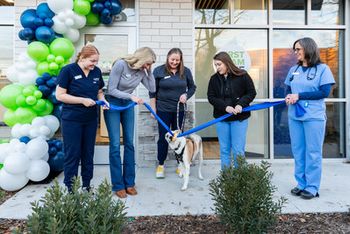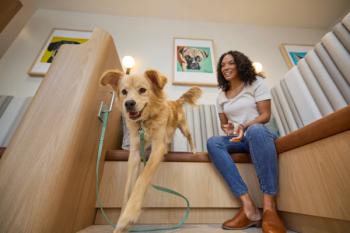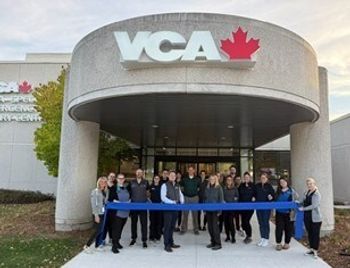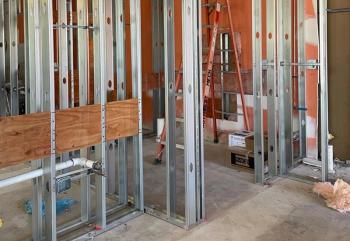
Offering emergency medicine with style
When Dr. Randy Spencer stepped outside his hospital doors 13 years ago and glanced around the growing suburb of Phoenix that surrounded First Regional Animal Hospital, he didn't like what he saw. Ten veterinary hospitals were situated within a 3-mile radius of the practice. "That kind of competition dampens productivity," says the 1987 Colorado State graduate.
By Carolyn Chapman, Special Assignments Editor
When Dr. Randy Spencer stepped outside his hospital doors 13 years ago and glanced around the growing suburb of Phoenix that surrounded First Regional Animal Hospital, he didn't like what he saw. Ten veterinary hospitals were situated within a 3-mile radius of the practice. "That kind of competition dampens productivity," says the 1987 Colorado State graduate.
On second glance, he had an epiphany: No emergency hospitals served the area. Six years later, Dr. Spencer's practice began offering 24-hour emergency care, turning his competitors into colleagues. And in 2001 the Chandler, Ariz., practice moved into new quarters: a 7,588-square-foot facility that serves both general and emergency care clients.
Shifting the focus from retail
When Dr. Spencer joined the hospital, then The American Pet Center, in 1986, the practice focused on one-stop shopping in its 2,500-square-foot leased space. "We were PetsMart before the superstore existed," he says, chuckling. He bought the practice in 1989, dropped the ancillary services, and renamed the hospital First Regional Animal Hospital to reflect the new focus on medicine. "Grooming, retail, and boarding just weren't generating enough income to justify the expense," he explains.
On Halloween 1995, the practice began offering 24-hour emergency care. And in 1996, a remodel into an adjacent bay doubled the practice space to 5,000 square feet. "We redesigned the entire hospital during the renovation," Dr. Spencer says. He admits that the expansion was a conservative step on the path to his goal. "I knew I wanted to build eventually, but I wasn't ready," he says. Still, before long poor visibility in the shopping center and interest in owning a facility prompted him to look for land.
He didn't look far. A 1-acre site sat across the street, but tax problems prevented Dr. Spencer from pursuing it. When another owner bought the plot and solved the tax issues, Dr. Spencer approached the new owner and purchased the land. The site had everything Dr. Spencer wanted: a corner lot to enhance visibility, proximity to other hospitals for referrals, and easy freeway access. The downside: some typical zoning and financing headaches. "I figured I'd have this hospital built in a year, but it took a year just to plan and obtain permits," he recalls.
Separate yet shared
When selecting an architect, Dr. Spencer pored over back issues featuring Veterinary Economics' winning designs. He chose Albuquerque, N.M., architect Wayne Usiak, AIA, and the two met at a conference to discuss the project. "I felt confident he could make the combination of the emergency and general practice work well," Dr. Spencer says.
Usiak drafted a floor plan based on a comprehensive questionnaire and a basic sketch Dr. Spencer created. Integrating the two practices in the same space proved Usiak's biggest challenge. "Each practice needed distinction for branding purposes," says Usiak. "We added a lot of innovations to separate the practices yet preserve the hospital's unity. For example, I incorporated an individual covered entry, a reception check-in area, and a waiting alcove into each practice."
Dr. Spencer hired local contractor Porter Brothers to build the hospital, and a neighbor, Glen Washburn, supervised the project. "Glen made my project his own and took a personal interest in making sure the work was done right the first time," Dr. Spencer says.
A flexible floor plan
Dr. Spencer selected masonry block for the exterior to establish a permanent look for the hospital. The natural block with red accents and aluminum blue window frames projects a professional appearance and blends with the desert landscaping, a city stipulation.
Set at a 90-degree angle to each other, each entrance opens to a separate waiting area, and a central reception desk serves both practices. A window wall with a French door and a salt-water aquarium separates the two waiting rooms. Clients enjoy the paw prints on the ceiling of the reception area. "This was an expensive detail, but it pays off in the 'wow' factor," says Dr. Spencer. "And it reflects our hospital theme, 'For the love of pets.' "
Six exam rooms and a business office line the interior sides of the reception area. On busy days, the general practice uses more exam rooms, and at night and on weekends, the emergency practice uses the space. A seventh room for triage and emergencies includes a lift table and sits just beyond the office near the emergency entrance.
The pharmacy spans the hallway behind exam rooms one to four and includes the staff mail center and a laptop charging area. The treatment area features four workstations. Oxygen drops in the walls offer more accessibility.
A mammoth ICU suite radiates off treatment. Two folding exam tables facilitate on-site exams, and two visitation cubicles give owners a place to enjoy visits with ailing pets.
The isolation ward sits between the ICU and surgery suite and enjoys easy outside access down a side hallway. "I wanted isolation to be accessible, because these cases are labor intensive," says Dr. Spencer. "The in-flow location increases efficiency."
The self-contained surgery pod features two surgery suites, a special procedures room, and a preoperative and pack/prep area. The surgery pod also includes two storage areas to keep bulk supply and rolling equipment on hand.
Four environmental zones keep the hospital temperate and odor free. Each zone has a separate rooftop HVAC unit, which permits maintenance without disturbing clients or staff members.
Quality counts
To others planning building projects, Dr. Spencer advises hiring high-quality project team members and trusting them to do their jobs. "Paying for quality from the beginning saved me money," he says.
Dr. Spencer says his new hospital is perfect for him and his team. "The architectural design allows for excellent patient care and monitoring," he says. "And clients enjoy visiting our hospital."
Carolyn Chapman, a former Veterinary Economics associate editor, is a freelance writer in Liberty, Mo.
July 2002 Veterinary Economics
Newsletter
From exam room tips to practice management insights, get trusted veterinary news delivered straight to your inbox—subscribe to dvm360.




